PAESAGGI – Italian: Literally landscape. As used by Italian
speaking engravers, paesaggi is used synonymously with “scene di caccia”
to indicate a game or hunting scene.
|
PALMCONTROL™ – An air impact freehand engraving system invented
and manufactured by Steve Lindsay Engraving & Tools. See
LINDSAY PALMCONTROL.
|
PANTOGRAPH ENGRAVING MACHINE – An instrument for copying a plane
figure to a desired scale, consisting of styluses for tracing and
copying mounted on four jointed rods in the form of a parallelogram
with extended sides. The portion of the pantograph that does the
engraving is either a diamond point stylus or a rotating cutter or
“mill.”
For items of jewelry the diamond point is used. The diamond does not
actually engrave the metal as does a graver, rather it scratches the
metal and is for that reason commonly known as “diamond drag”
engraving. The milling head is used for engraving plastic signs and
name badges as well as for making dies and hobs.
In the jewelry and sign business, the New Hermes brand of pantograph
engraving machine (under the trade name of Engravograph) once dominated
the field whereas among die makers, the names Alexander, Cornite,
Gorton and Deckel predominate with more robust and precise equipment.
While the tracing arm and stylus or cutter contact of a pantograph is
operated by hand, such work is known as “machine engraving” and not
“hand engraving” within the traditional meaning of the term. Hand
engraving is done with a graver that is controlled in a freehand
manner.
Manual pantograph engraving machines have largely been displaced in the
jewelry; sign and award businesses by computer programmed and operated
systems. These systems continue to use the diamond stylus and rotating
cutter except in the case of laser engraving systems.
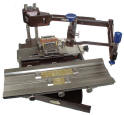
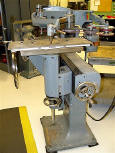
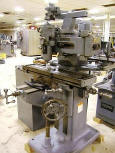
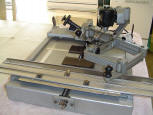
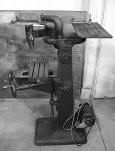
Pictured is a "diamond drag" pantograph by Pepe Tools and four milling
pantographs by Alexander, Gorton, New Hermes, and Deckel.
|
PATCH BOX - A receptacle in the stock of a muzzle-loading rifle
for holding bullet patches, grease, and small tools. American long
rifles, also known as Kentucky or Pennsylvania rifles, were often
fitted with elaborately pierced and engraved patch boxes of brass or
German silver.
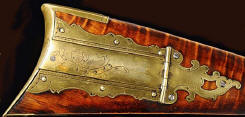

Pictured are two examples of engraved patch boxes mounted on antique
rifles.
|
PHIL COGGEN BULINO TEMPLATE – A sharpening template manufactured
and distributed by Steve Lindsay Engraving & Tools of Kearney, Nebraska
and designed by noted British gun engraver Phil Coggan of Wales, UK.
Gravers sharpened with the Coggan template are to be used for long and
short ultra fine lines and bulino dots. Coggan also uses gravers
sharpened in this manner for fine lettering.
http://www.handgravers.com/sharpening.htm
http://www.handengravingforum.com/showthread.php?t=2315

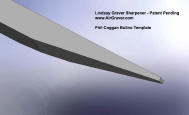
Pictured is the Phil Coggan template and the graver point made from it.
|
PICK – A term used in lettering meaning to “square-off” a flat
graver cut or a script cut such as the top of a lower case “t.”
|
PHOTOENGRAVING – A photomechanical process for making line cuts
and halftone cuts by photographing an image on metal and then etching.
For arms, this process is usually used for mass produced decoration
such as commemorative issues.
|
PICKING-UP (metal) – While engraving certain metals, such as
aluminum, brass, or copper, a deposit of the metal will build up on the
heel of the graver causing a dulled appearance to the cut. Engravers
dip the tip of the graver into any of a number of preferred oils to
prevent picking-up. Also known as “loading” or “build-up.”
|
PIERCING – Also known as “saw piercing”, this technique is
common to the jewelry trade. In piercing, the design is laid out on the
metal object then engraved. Next, a small hole is drilled in a part of
the design’s background. A fine saw blade is then inserted through the
hole after which the blade is clamped into the frame of a jeweler’s
saw. The saw is then used to cut away the background while the object
is held against a “bench pin” made of wood. The saw blade is then
removed from the saw and the process is repeated for the next section
of background. On guns, piercing is usually used only on trigger guards
and top levers. Sometimes referred to as “filigree.”

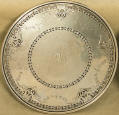
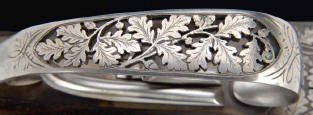

Pictured are two trigger guards engraved and pierced by Carl B. Bleile
of Cincinnati. Also pictured is an item of engraved and pierced silver
and another trigger guard engraved and pierced with an oak leaf design.
The cuff bracelet pictured was pierced and engraved by Chris Malouf of
West Virginia.
|
PITCH BLOCK or PITCH BOWL – As used by hand engravers, a pitch block or
pitch bowl is a receptacle containing dried, hardened pitch which, when
heated, allows the placement and holding of irregularly shaped or very
thin items to be held for engraving once the heated pitch rehardens.
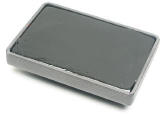
Pictured is a GRS pitch block which is made to be mounted in an
engraver's block.
|
PLANISH – To make smooth or plane, as a metallic surface; to
condense, toughen, polish or shape by light blows with a hammer or
punch.
|
POINT OF ORIGIN – In the design of ornamental scrollwork,
hand engravers use the term “point of origin” to describe the place in
a design from which all of the vines and leaves begin. The point of
origin is usually a closed end starter scroll, an edge, or (on guns) a
screw hole. Trained engravers are taught to never start an open scroll
in open space. In most cases scrolls are designed to grow away from the
point of origin.
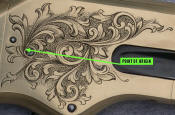

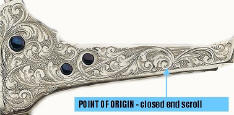
Pictured is the sideplate of a brass-framed rifle where the point of
origin is located at a screw hole. The scroll on the brass buckle has
its point of origin on the border and the scrollwork on the revolver
frame uses a closed end scroll as its point of origin.
|
POTTER’S WHEEL VISE – A set-up for hammer & chisel engraving
whereby the vise is mounted on a shaft, the bottom of which has a kick
wheel similar to that used by a potter for throwing pots. The engraver
is thus able to move the work piece without stopping a cut to move it
with his hand, as would be the case if he were using a block sitting on
a bench or post.
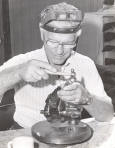
In this picture the late Neil Hartleip is seen engraving using a
potter's wheel vise. Note that both of Neil's hands are free to engrave
while he moves the position of the vise with a foot wheel under his
bench.
|
POWER HONE – An electric motor within a housing that drives
either a ceramic, disc shaped lap or diamond impregnated, metal disc
for use in sharpening gravers. Power hones are often used in
conjunction with a sharpening fixture or template but some engravers
use them for freehand sharpening as well. GRS and T. W. Designs
manufacture the most popular power hones.
http://www.handgravers.com/sharpening.htm
http://users.commspeed.net/ttwhite/hone.htm
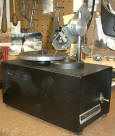
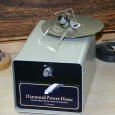
Pictured are a GRS power hone with a GRS sharpening fixture and graver
mounted and another power hone by TW Designs with a Lindsay universal
sharpening template and graver mounted.
|
PRACTICE PLATE – Any small piece of metal, usually rectangular
or square and flat, used by beginning and intermediate engraver to
practice engraving or inlaying techniques for the improvement of their
skills. Often highly skilled engravers will engrave such a plate for
the purpose of demonstration or exposition. Such plates are useful
where a gun, knife or other items are not practical for transport or
display. Such plates engraved by experts are more correctly referred to
as “demonstration plates” or “exhibition plates.”
|
PROFESSIONAL ENGRAVER – One who earns money from the trade of
engraving either full or part time.
|
PROGRESS MARKS – Minute step-like cuts left in engraved lines
when executed with hammer and chisel. The larger the chisel and the
heavier the hammer, the more pronounced the progress marks. Power
driven gravers can also leave progress marks when operated at a slow
stroke setting however when operated at normal speeds, air powered
gravers leave progress marks so slight as to be visible only under
powerful magnification. The electrically powered Magnagraver will leave
progress marks like hammer and chisel when operated at slow to medium
speeds.
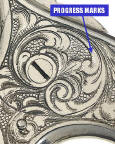
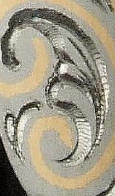
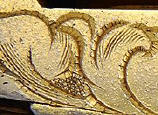
Progress marks can be clearly seen as the step-like cuts in the
scrollwork in the examples pictured.
|
PULL – A print made by one of several methods from the engraved
surface of an engraver’s work piece. Some pulls appear in negative, by
printing from the top surface, and some in positive by drawing the ink
or lampblack out of the cuts. Today this is usually accomplished with
clear packing or bookbinding tape. The engraver, as a work record,
saves these pulls. Also known as a “smoke pull.”
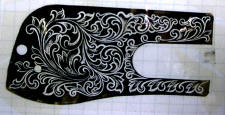
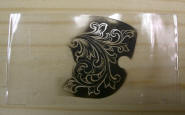
|
PUNCH – A tool made to be struck by a hammer so as to imprint a
design, letter, or numeral into metal. Punches are most often used by
engravers to matt the background of scroll or floral designs, however
they are also used to move and shape metal in relief sculpting.
Backgrounding punches usually impress a tiny circle, dot or texture
into the metal.
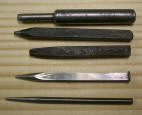
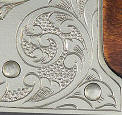
Pictured is an assortment of punches and an example of simple
scrollwork whose background has been textured with a circle or beading
punch.
|
PUNCH DOT ENGRAVING – To American engravers and gun collectors,
this term means decoration in metal, which was done with a punch or
punches and a few cuts with a graver. The best-known example of this
style is found on Merwin Hulbert firearms of the late 19th or early
20th centuries as well as many lesser-known “cheap” revolvers of the
same period.
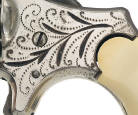
Pictured is an antique revolver decorated with "punch dot" scrolls and
a few bold graver cuts.
|
PUNCH WORK – To older British engravers this term means an
inexpensive grade of factory engraving done by two engravers. One cuts
the scroll spirals with a hammer and chisel; the other cuts the inner
leaves with a burin.
Punch work is also common on decorative brass wear made in Asia where
serving trays and other house wares are decorated with a variety of
punches and some crude engraving.
|
PUNTA – Italian: Literally tip. As used by Italian speaking
engravers, punta is used to mean what English speaking engravers call a
“chisel.”
|
PUNTA e MARTELLO – Italian: Literally tip and hammer. As used by
Italian speaking engravers, punta e martello is used to mean what
English speaking engravers call “hammer and chisel.”
|
PUSH ENGRAVED – Engraved with a “push graver.” Another way of
saying engraved with a burin or engraved with a graver with no power or
hammer assist.
|
PUSH GRAVER – Another name for a burin as distinguished from a
chisel or power operated graver.
|